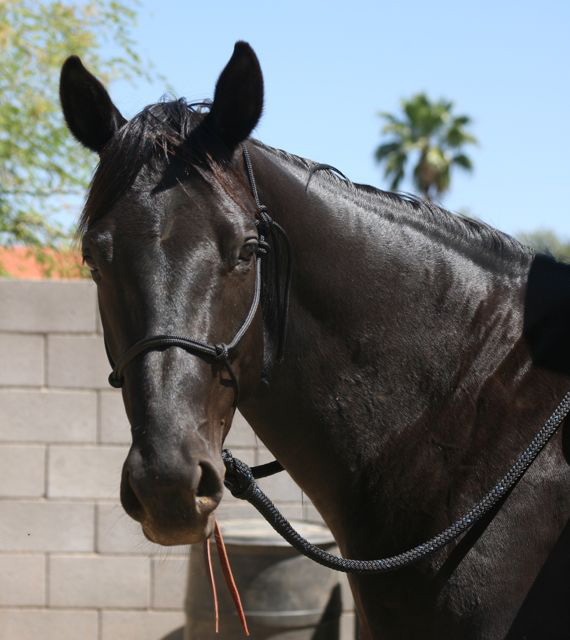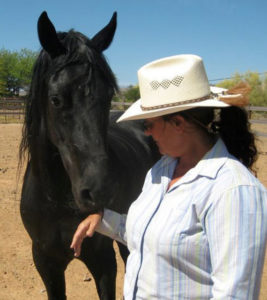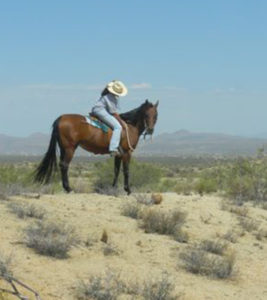Posted question:
They are pricey, but everything I read (From the manufacturer, MikMar) says they are easy on the horse and give back all the things we crave, head set, quick response etc. I am not an expert at all so if you do get any real use feed back that would be great. I also have been doing a ton of research on this bit. Although it looks quite aggressive, it is a very kind bit and I thought it would work better for Rocko seeing I can be a little heavy handed sometimes. =( I called the company, they were very helpful when I told them just what I was looking for in a bit. With the training bit, the signal does not go right to the mouth first.
Answer:
Bits are a concept in addition to an actual piece of mechanical manipulation. Anything a bit maker tells you it will do is marketing. Now, I’m not saying it won’t do it. But, I will say that it will only do ‘it’ for a while. Perhaps a short while and perhaps a little longer, but the culprit is always the rider’s hands, skill level and offer to the horse to keep getting better. Sometimes a conversation happens where I mention riding one of my horses in the mountains without a bridle (a string around the neck for, you know, safety). The ‘knowledgeable horse person’ gets a stern, bordering on rude tone to tell me how dangerous and irresponsible that is. The horse could run off with me. Well, says I, I’m sure you’ve seen horses run away with their riders, frequently at shows – and they always have bridles and saddles on, so I guess that isn’t the answer. Let’s address the points in the above post: easy on the horse. How is that possible to say when people can and do use their entire body weight thrown against a piece of metal in the horse’s mouth? Easy – when there is no immediate problem is a lot different than easy when panic or crisis mode kicks in. Many folks simply do not know what their hands are doing and the horse pays for this, sometimes dearly. The design of that particular bit is made to affect the horse in four different ways (used as part of the marketing, too). But to look at this from the horse’s view, the person will use four pressure points to get his way. Basically, it’s possible to ‘make’ the horse carry it’s head the way we want, not toss it, not go too fast AND turn immediately. So EASY to pressure four areas with hands/body weight that lost balance and is hanging on the reins. Yes, I understand that a nice head carriage and responsive horse is a goal of most riders, but that should be a rider training goal not something the horse pays for. For that to be the goal of those with skills that can’t accomplish it with a snaffle seems unfair to me. BTW, a snaffle is NOT the break in the middle. If there is a shank with a break it’s a broken curb. A snaffle has the headstall and the rein attach to the same ring with no shank. You can have a snaffle that is a straight bar, called a Mullen mouth.
To market that the pressure doesn’t go to the bit first is misleading at the very least. If a loose rein swings, a horse can feel it in his mouth. By the time contact is taken up he’s already decided to give or brace. Add hands that haven’t developed ‘feel’ yet, and all four pressure points are going to be used PDQ. This is where ALL the available pressures come in to tell the horse that he’d better do as told. However, if the person is inexperienced, they are telling the horse to do things they don’t know they’re telling him. The horse is probably doing just as the hands are indicating and the person thinks the horse is disobeying.

 I was her last stop before the Alpo can. This girl is the most dangerous horse I’ve ever been around in my life. What did “they” do to her to make her so dangerous? And by dangerous, I mean: She allowed no one near her. Within range for her was anywhere she could reach or get to. She’d charge you, even lunging over the fence. Just hope you get through it and far enough away to live. She struck, bit and kicked, launched whatever cowboy got on her and then, like a bull, turned and attacked. Broke bones in several trainers bodies before coming to me at the ripe old age of three. The trainers who owned her could not get within thirty feet of a fence without her trying to attack them. They purchased her as a one-year-old at the World sale in OK and when the breeder went into the stall, she sent him flying over the stall wall and broke some parts. The trainer/owner had gotten on her, but she launched him and then like a bull, turned and attacked breaking his collar bone. She had to be removed from the stable where they trained because no one could even clean the stall. They sent her to a trainer whose business card USED to read “Problem horses a specialty.” She launched him and attacked again with the same result. he told them to come get her, she was hopeless. They turned her out in a 100 acre pasture for six months hoping she’d settle down, but the other people who had horses in the pasture couldn’t get their horses because she’d attack them. She was temporarily contained in a round pen of a mutual acquintance while they tried to figure out what to do with her. They had the vet out to draw blood to check for hormone problems. If anyone even placed a hand on her, she’d squeal and kick and squirt pee. While in the stock for the vet to draw the blood, she managed to kick him and break his arm. Blood tests were negative. The mutual acquintance said if they wanted to give her one more shot before they took her to the killers, she needed to go to Lauren’s. (I keep a low profile. They didn’t know me.) They said drug her, throw her in the trailer and get her over there. I was gone to lessons the morning she was to be delivered, so I left instructions to leave her in the round pen. Now I was not given any info on this horse, just that they wanted her to “go long and low at a lope.” I had a message on my cell that said, “Hope your pen is still up when you get home.” Hmmmmm….. I walked out to see the new arrival. As I approached the fence, this beautiful horse ambled toward me and started to put her head forward. I noticed that she had a rear hoof that was completely broken up to the hair line at the quarter line. Lots of fresh blood. Don’t know what happened getting her here. I reached up a hand to pet her face and suddenly, both hind hooves were over the 5 foot rail right at my head. “Oh sweetheart,” I said, “that’s not the way we do things here.” She then pinned her ears and lunged over the rail at me with her teeth and eyes snapping. Yikes! I got my stick and string so I could work with her in the pen and hopefully live. She didn’t have a halter on and I was pretty sure I didn’t want to be close enough to put one on her anyway. I had to do some pretty good swinging to even get in the pen and keep her off me. She didn’t care. I felt bad about the broken hoof, but it was obvious that that would be a long time healing and there wasn’t anything I could do about it. She didn’t seem to care either. High, shut-down pain threshold. I sent her off while she tried to attack and then bolted off squealing and squirting pee about 4-5 feet straight out behind her. I tested several options for her to come in or quiet down, the answer was a resounding “NO”. I was running around with her so I could touch her with the string and also use it when she attacked to start our conversation. Getting her to go away was important as a precursor to her giving to pressure and not killing me. She had no inclination to do so and there were many times that I knew my life was seriously in danger. To make a long story short, two hours later, both of us were covered in sweat and pee. She was changing direction and sometimes coming in half way to me. Then, suddenly she just stopped, turned in to me and walked up to me with her head down at her knees. She stood there heaving and dripping with her tail hangling limp between her legs and pee just started pouring out of her. I petted her forehead and said, “Sweetheart, where in the world did you even have that after two hours of squirting it all over?” Whatever happened to this horse before, she decided that she was going to get the human before the human could get her. I found out later that in addition to the multitud of broken bones she left in her wake, the owner had tied her legs and thrown her and left her laying in the sun under a tarp for several hours. She also had several serious wounds that they had stitched up on her lower legs without the help of a vet. Those scars will remain, the mind scars have mostly healed. I absolutely adore this horse and she’s like a barnacle. Follows me everywhere and always is a huge help teaching other horses how to do tricks and work with sidepassing over barrels or walking in the tire bundle or tarp work. She’s always right there on her own (frequently in the way) to show the newbie how to do it.
I was her last stop before the Alpo can. This girl is the most dangerous horse I’ve ever been around in my life. What did “they” do to her to make her so dangerous? And by dangerous, I mean: She allowed no one near her. Within range for her was anywhere she could reach or get to. She’d charge you, even lunging over the fence. Just hope you get through it and far enough away to live. She struck, bit and kicked, launched whatever cowboy got on her and then, like a bull, turned and attacked. Broke bones in several trainers bodies before coming to me at the ripe old age of three. The trainers who owned her could not get within thirty feet of a fence without her trying to attack them. They purchased her as a one-year-old at the World sale in OK and when the breeder went into the stall, she sent him flying over the stall wall and broke some parts. The trainer/owner had gotten on her, but she launched him and then like a bull, turned and attacked breaking his collar bone. She had to be removed from the stable where they trained because no one could even clean the stall. They sent her to a trainer whose business card USED to read “Problem horses a specialty.” She launched him and attacked again with the same result. he told them to come get her, she was hopeless. They turned her out in a 100 acre pasture for six months hoping she’d settle down, but the other people who had horses in the pasture couldn’t get their horses because she’d attack them. She was temporarily contained in a round pen of a mutual acquintance while they tried to figure out what to do with her. They had the vet out to draw blood to check for hormone problems. If anyone even placed a hand on her, she’d squeal and kick and squirt pee. While in the stock for the vet to draw the blood, she managed to kick him and break his arm. Blood tests were negative. The mutual acquintance said if they wanted to give her one more shot before they took her to the killers, she needed to go to Lauren’s. (I keep a low profile. They didn’t know me.) They said drug her, throw her in the trailer and get her over there. I was gone to lessons the morning she was to be delivered, so I left instructions to leave her in the round pen. Now I was not given any info on this horse, just that they wanted her to “go long and low at a lope.” I had a message on my cell that said, “Hope your pen is still up when you get home.” Hmmmmm….. I walked out to see the new arrival. As I approached the fence, this beautiful horse ambled toward me and started to put her head forward. I noticed that she had a rear hoof that was completely broken up to the hair line at the quarter line. Lots of fresh blood. Don’t know what happened getting her here. I reached up a hand to pet her face and suddenly, both hind hooves were over the 5 foot rail right at my head. “Oh sweetheart,” I said, “that’s not the way we do things here.” She then pinned her ears and lunged over the rail at me with her teeth and eyes snapping. Yikes! I got my stick and string so I could work with her in the pen and hopefully live. She didn’t have a halter on and I was pretty sure I didn’t want to be close enough to put one on her anyway. I had to do some pretty good swinging to even get in the pen and keep her off me. She didn’t care. I felt bad about the broken hoof, but it was obvious that that would be a long time healing and there wasn’t anything I could do about it. She didn’t seem to care either. High, shut-down pain threshold. I sent her off while she tried to attack and then bolted off squealing and squirting pee about 4-5 feet straight out behind her. I tested several options for her to come in or quiet down, the answer was a resounding “NO”. I was running around with her so I could touch her with the string and also use it when she attacked to start our conversation. Getting her to go away was important as a precursor to her giving to pressure and not killing me. She had no inclination to do so and there were many times that I knew my life was seriously in danger. To make a long story short, two hours later, both of us were covered in sweat and pee. She was changing direction and sometimes coming in half way to me. Then, suddenly she just stopped, turned in to me and walked up to me with her head down at her knees. She stood there heaving and dripping with her tail hangling limp between her legs and pee just started pouring out of her. I petted her forehead and said, “Sweetheart, where in the world did you even have that after two hours of squirting it all over?” Whatever happened to this horse before, she decided that she was going to get the human before the human could get her. I found out later that in addition to the multitud of broken bones she left in her wake, the owner had tied her legs and thrown her and left her laying in the sun under a tarp for several hours. She also had several serious wounds that they had stitched up on her lower legs without the help of a vet. Those scars will remain, the mind scars have mostly healed. I absolutely adore this horse and she’s like a barnacle. Follows me everywhere and always is a huge help teaching other horses how to do tricks and work with sidepassing over barrels or walking in the tire bundle or tarp work. She’s always right there on her own (frequently in the way) to show the newbie how to do it. She was ten years old and had been kept in a pen for so long her legs hardly held up and sometimes didn’t while she scrambled to bolt away. A jet black Morgan, stunningly beautiful with black eyes, flowing mane and tail and crooked hind legs and strangely shaped hind hooves. Talk about spooky – I ducked between the rails of the pen she was in and she tried to jump out the back side. The guy who ‘trained’ her, well, he thinks standing in a round pen while she frantically runs so out of control that she’s at a 45 degree angle with the footing flinging hither and thither 30 feet out. She was in a total lather and had to be blocked to stop. Her eyes were white with terror. He, meanwhile, stood there in the ‘position’ with his arm cocked leaning on his stick while she lost her mind. Then, he saddled her up and got on and kinda rode her. Meaning he stayed on at a very tense walk and trot with reins only a few inces long and couldn’t get her any where near the rail or canter. A year later, after standing in that same pen the whole time, I brought her home amd turned her out with my herd. BTW she couldn’t be caught. What a lover puss. While she will come, she still has a thought that if you have a rope it may not go well for her. I’ve only been on her a handful of times and that bareback with a halter, but she’s doing very well. Updates as I get around to them.
She was ten years old and had been kept in a pen for so long her legs hardly held up and sometimes didn’t while she scrambled to bolt away. A jet black Morgan, stunningly beautiful with black eyes, flowing mane and tail and crooked hind legs and strangely shaped hind hooves. Talk about spooky – I ducked between the rails of the pen she was in and she tried to jump out the back side. The guy who ‘trained’ her, well, he thinks standing in a round pen while she frantically runs so out of control that she’s at a 45 degree angle with the footing flinging hither and thither 30 feet out. She was in a total lather and had to be blocked to stop. Her eyes were white with terror. He, meanwhile, stood there in the ‘position’ with his arm cocked leaning on his stick while she lost her mind. Then, he saddled her up and got on and kinda rode her. Meaning he stayed on at a very tense walk and trot with reins only a few inces long and couldn’t get her any where near the rail or canter. A year later, after standing in that same pen the whole time, I brought her home amd turned her out with my herd. BTW she couldn’t be caught. What a lover puss. While she will come, she still has a thought that if you have a rope it may not go well for her. I’ve only been on her a handful of times and that bareback with a halter, but she’s doing very well. Updates as I get around to them. Would you take that one with you, too?” the owner asked me. I made a face. I was there to see about a throw away (by them) horse for my daughter (Gryffindor is on the cover of my book with her). “No.” I said. “That’s like a large Great Dane. I don’t have any use for a tiny Arab pony.” But, the little bay horse whispered, “I’ll be your best horse ever.” Believe me, I throw that up in her face every once in a while when she gets a hair up her butt and she’s not being my best horse ever. She weighs about 200 pounds more than she did then. And with only about 225 rides in her, she’s a phenomenal horse. She’s perfectly behaved galloping in the mountains bridle-less with just a string around her neck that I don’t have to use. She’s so smooth in her gaits. She jumps like a bird; completely quiet and composed and we’ve started working on piaffe. I can put someone who’s never been on a horse before on her with a halter and take them for a ride in the desert or mountains. She’s also the one I’m on laying backward reading a book and in the un-spooky horse blog post. As to the reading picture, she had never been in the backyard, I had never laid backward on her. She didn’t even have so much as a string around her neck for that photo shoot. Very smart, but that’s an Arab for ya. Tell her what you want and be clear about it and she’ll give it her best try. I’ll keep adding blog posts featuring her and stories of old as we go.
Would you take that one with you, too?” the owner asked me. I made a face. I was there to see about a throw away (by them) horse for my daughter (Gryffindor is on the cover of my book with her). “No.” I said. “That’s like a large Great Dane. I don’t have any use for a tiny Arab pony.” But, the little bay horse whispered, “I’ll be your best horse ever.” Believe me, I throw that up in her face every once in a while when she gets a hair up her butt and she’s not being my best horse ever. She weighs about 200 pounds more than she did then. And with only about 225 rides in her, she’s a phenomenal horse. She’s perfectly behaved galloping in the mountains bridle-less with just a string around her neck that I don’t have to use. She’s so smooth in her gaits. She jumps like a bird; completely quiet and composed and we’ve started working on piaffe. I can put someone who’s never been on a horse before on her with a halter and take them for a ride in the desert or mountains. She’s also the one I’m on laying backward reading a book and in the un-spooky horse blog post. As to the reading picture, she had never been in the backyard, I had never laid backward on her. She didn’t even have so much as a string around her neck for that photo shoot. Very smart, but that’s an Arab for ya. Tell her what you want and be clear about it and she’ll give it her best try. I’ll keep adding blog posts featuring her and stories of old as we go.
Recent Comments